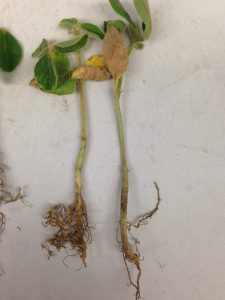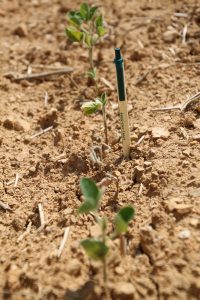Jarrod Miller, Extension Educator, Somerset County
It’s often multiple factors that lead to injury and loss, making it difficult to determine a direct cause. Of these factors, weather is often out of our control, but we can make choices about crop rotation and herbicide selection. A field in Western Maryland under a continuous soybean – wheat – DC soybean rotation had some issues this spring. Our Washington County Ag agent Jeff Semler noted that the field had been planted May 1, but started having issues the first week of June. In the photo below are spots of dead and injured plants spread across the field.

Results revealed multiple issues, including fungal diseases which cause root rot (fusarium and pythium) as well as herbicide damage. Lesions on soybean cotyledons (see photo below) could be the result of PPO herbicides (Sharpen, Valor, Reflex, ect). All three issues (fusarium, pythium and PPOs) are more likely to cause problems when soils are cool and wet, something out of your control.

Sharpen must be activated by 1/2 rain and is more water soluble, so it may be taken up by the plant. Valor may be splashed onto plant tissues during rainfall. Cotyledons are likely to be effected during emergence, when they may come into contact with herbicide residuals in the soil. Reading the label can help reduce any issues with these herbicides. For example, label recommendations for Sharpen restrict planting of soybeans from 0 to 44 days depending on soil texture and application rate. So while you can’t control the weather, you can control your pre-plant interval, reducing the likelihood of injury.

Fusarium and pythium are often found on roots together, and infection can be enhanced by herbicide injury, soil compaction or other plant stressors. It is important to understand what you can control (compaction, pH and fertility) and manage the best you can. It is likely that herbicide injury allowed diseases a better chance at infecting these soybeans. Robert Kratochvil (UMD Agronomist) recommends rotation in this case, as these diseases are likely to be found on last years residue. If commodity prices and weather reduce your ability to rotate, look for resistant varieties. But no matter how well you manage your fields, issues are bound to arise.
